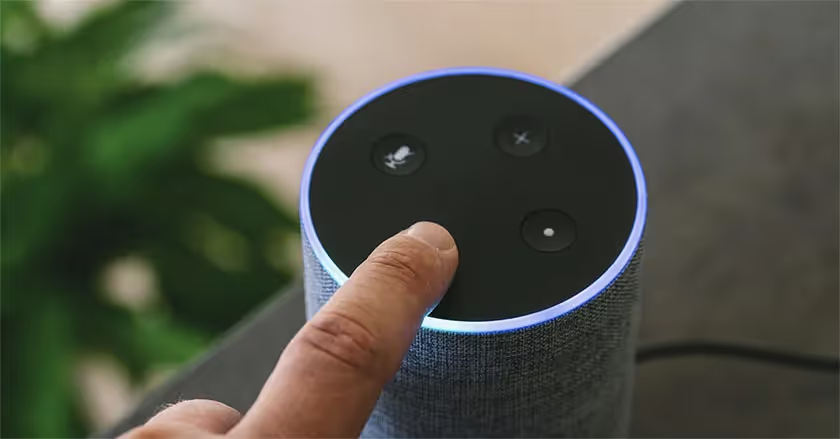Digital Assistants Are Changing the Way We Buy and Sell
Could Alexa help you advertise and sell products on Amazon? Here's how digital assistants are changing the way customers buy online.
“Alexa, what dog food should I buy for Brutus?”
Whether it’s getting kibble recommendations, or reordering your favorite shampoo, digital assistants are changing the online retail game. A successful brand excels at providing product suggestions when a customer needs it most and services like the Amazon Alexa or Google Assistant have opened up a world opportunity to meet your customers’ needs. And if you’re an eCommerce professional, you need to be paying attention.
What is a voice assistant?
Built using machine learning technology, a voice assistant is a digital concierge that can answer questions and perform tasks for the owner. Alerted by voice commands, a voice assistant can help users request an Uber, set timers, or even order a product. By reducing the friction between daily life and devices, digital assistants have grown in popularity - one in six people in the United States now own an activated voice assistant.
With increased adoption in households or on the go, digital assistants are the next logical step in human efficiency, media consumption, and online shopping. This is especially significant for brands. In just five years, 87 percent of consumers will expect to be able to reach their favorite brands and 72 percent of consumers will expect to purchase from their favorite brands with the help of a voice assistant, according to Bing Ads.

What are voice assistant’s shopping capabilities in reference to retail and eCommerce? Digital assistants are already making shopping easier for consumers. The two most popular assistants, Amazon Alexa and Google Assistant, allow users to buy their favorite products and track those orders through Alexa or Google Assistant enabled devices.

Shopping with Google Assistant
Buying products from stores like Walmart, Costco, and Target is easier than ever when a consumer uses Google’s personal shopping service, Google Express. Once payment information and a shipping address have been entered, users can activate Google’s shopping assistant by saying something as simple as “Ok Google, I need to order more shampoo.” Typical of Google’s user experience, the more a user shops, the personalized their product recommendations will be. Most merchants now offer free delivery on orders over $35.00.
Shopping with Amazon Alexa
Alexa Voice Shopping is an Amazon service that allows users to order anything they need through Amazon. By simply telling an Alexa-enabled device what you want to buy, the shopping assistant will use a consumer’s purchase history to make recommendations. A feature unique to Amazon’s shopping assistant is the ability to search deals. By saying, "Alexa, what are your deals?" users get access to exclusive deals through Alexa. Although only 2% of people with Amazon-Alexa enabled devices made a purchase via voice in 2018, brands will see that figure grow as user experience and accessibility improves.
What does the future of voice assist look like for retail and eCommerce?
Smart home = smart shopping The future is bright for online retail and voice-enabled shopping assistants, largely due to appliance brands like Whirlpool and LG creating a more connected smart-home ecosystem. Washing machines are now being created with built-in Google Assistant and Amazon Alexa integrations, which means consumers will no longer need to pull out their phone to order more detergent. At CES 2017, LG introduced an Alexa-enabled smart-fridge that suggests recipes that include the spinach that is expiring soon. And once it’s gone, will prompt you to order more.
Away from home
Voice assistants are appearing everywhere, not just at home. In the workplace, Amazon’s Alexa for Business can assist with everyday tasks at the office, such as notifying IT of an issue, ordering more office supplies, or managing your calendar. Marriott hotels will soon have Alexa-enabled rooms, letting guests do all sorts of things from closing the blinds to ordering pizza.

User experience and adoption
As the design for digital assistants evolve and improve, more users are likely to embrace voice-assisted shopping. All revolutionary technology is met with skepticism. Online shopping was a new, uncomfortable concept for consumers when it was first introduced in 1994, and now 96 percent of Americans shop online. The first popular voice assistant - Siri - was only introduced in 2010. Now, nearly half of Americans use a voice assistant on their smartphone. Voice assistants and online retail can now collide harmoniously as companies like Amazon and Google continue to improve their services.
How will voice impact my eCommerce business?
Now that we’ve established that voice is a big part of the future, how will it impact your business?
Text search will transition to voice
The use of voice-enabled devices has increased dramatically over the last few years, and by 2020, it is predicted that 50 percent of all searches will be voice-based. Humanizing the descriptions of product features, FAQs, and common concerns will help voice-assisted product research will flow smoothly. This will benefit brands who adopt a natural-sounding brand voice and include conversational language in their content and product pages.
Shopping will still be visual
For higher-dollar items like electronics, clothing, and furniture, customers will continue to research products through visual mediums. Voice-enabled smart TVs and integrated video content will play a key role in attracting customers to buy more expensive items from their living room.
The rise of shopping lists
Basic digital shopping lists now live in every voice-enabled device, and it would be safe to anticipate that shopping lists will become a desirable space for advertisers. Knowing the user already plans to buy an item will allow advertisers to offer deals specific to that shopper.
Brands are already delighting and assisting customers through Alexa Skills
There are now over 30,000 “Skills” (voice-based apps) on the Amazon market. A great example of how brands engage customers is the Tide – Stain Remover skill. Consumers can use Alexa to ask Tide how to remove thousands of different stains, followed by a step-by-step guide on how (and naturally, a Tide product recommendation). By gathering and understanding insights on customer experience, brands can find a way to bring even more utility and convenience to the voice-enabled shopping experience.
How can I prepare for the collision of voice and eCommerce?
With a handful of sound predictions and still many unknowns, brands can start preparing based on what is already working in the voice-enabled search ecosystem.
Adopt a conversational keyword strategy
The only constant in the digital space is change. Since Google is always updating its search algorithm to show users the most relevant results, brands that do business online need to continuously refresh keyword strategies to meet the demands of new search trends, in this case voice-enabled search. Updating search phrases to be more conversational is a good place to start. For example, brands could have more success using search phrases like “What is the best brand of coffee” versus “best coffee brand”.
Make sure your website HTTPS secured
HTTPS (the “S” stands for secured) is primarily used to product online transactions like banking and online shopping forms. 70.4 percent of voice search results maintain a secured URL, which is 20 percent more than desktop results. If you’re in the online retail space, making sure your website is HTTPS secured will make it that much easier for voice-enabled shoppers to find your website.
Adapt content pages
As your brand creates and refines its product and content pages, consider how prospective customers will want their questions answered. An excellent way to start creating conversational content is through your Frequently Asked Questions page. Anticipating your customers’ questions ahead of time will help with SEO rankings and make things easier in the long run for your company’s customer service team.
Win the feature snippet space
Although Google still won’t share how to compete for what many call “position zero”, there are methods that SEO experts agree will help your chances. Maintaining SEO best practices and having a clear and informative FAQ webpage are two methods that can help you occupy the coveted feature snippet on Google.
Keep and improve on your domain authority
Domain authority is the rating that Google uses to sort which websites rank at the top of search results. How your page ranks on search engines will determine voice-enabled shoppers to find your products. How to improve your website’s domain authority: - Speed up loading time for web pages - Create shareable, social media-friendly content - Polish page SEO and readability - Build your outbound and inbound links - Fix 404 errors or broken links
Conclusion
It’s an exciting era to be in eCommerce, and the brands that prepare well and adapt quickly to changes will benefit from the rising popularity of voice-assisted shopping. With consumers already embracing voice assistants, voice will be a key ingredient for the future of online shopping. Interested in learning about developing an ecommerce strategy to include voice assist? Fill out the form below to get more information.


.jpg)





.jpg)

